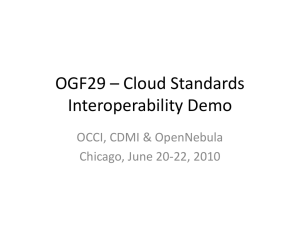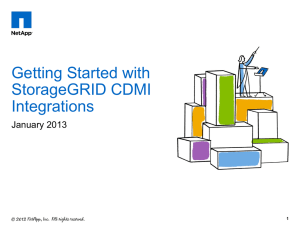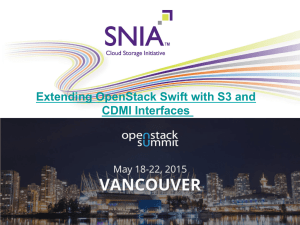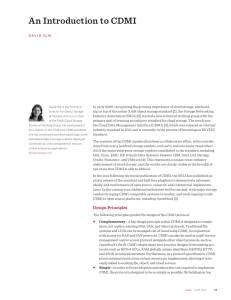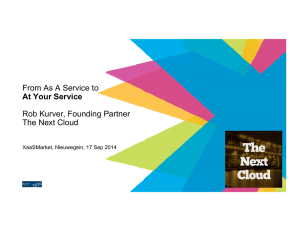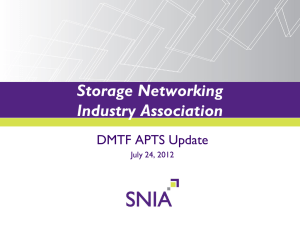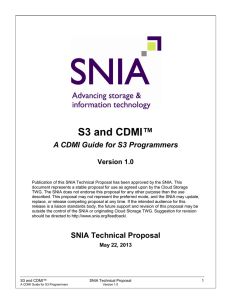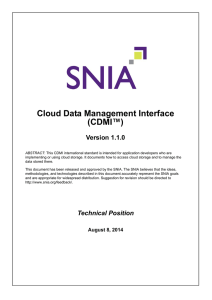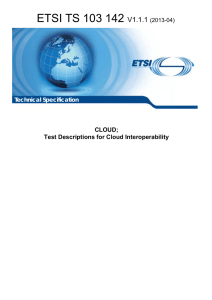CDMI: An Overview - NetApp Community
advertisement
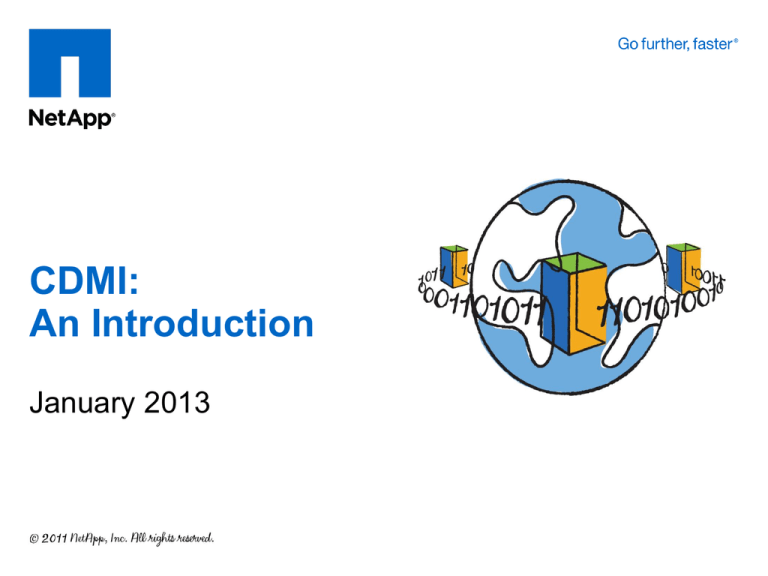
CDMI: An Introduction January 2013 Big Data “Big Data” refers to datasets whose size is beyond the ability of typical tools to capture, store, manage and analyze Complexity Speed Volume 2 Trends Shaping the Big Data Market Scale – 10’s PB of data, millions of users – “Life time retention” of data Object Access – Object = Data + Metadata – APIs/Protocols to provide object access Automatic Data Management – Object granular automated data mobility and management Distributed Access – Multi-location repositories, data mobility, local view/access 3 Cloud Storage Commonly used term to describe a data store deployment Apt to describe a Big Data store, increasingly characterized by: – Object based access and APIs – Multi-protocol support (NAS: NFS/CIFS/Object, SAN: FC/iSCSI) – Automatic policy-driven management based on object metadata – Provides services like billing, audit, security – Globally federated clouds Formal term: Data Storage as a Service (DaaS) What is CDMI? Cloud Data Management Interface CDMI is a open standard for cloud storage – Defines client-to-cloud and cloud-to-cloud interactions – Defines object semantics for content stored in the cloud SNIA Cloud Interactions Filesystem Clients CIFS/ NFS Existing Cloud APIs CDMI API Cloud Federation and Peering Cloud API Clients Existing Cloud APIs CDMI Notification Feeds, Accounting, Membership, etc... NetApp Confidential - Internal Use Only CDMI API Clients CDMI API Notification, Workflow, Audit, Billing, Authorization 5 What does CDMI let you do? CDMI allows clients to store and retrieve from the cloud – Named Objects (Accessed by name, similar to files) – Nameless Objects (Accessed by ID) – Queues (first-in-first-out structured storage) CDMI allows clients to organize stored content – Containers (Groups of named objects, similar to directories) CDMI allows clients to manage stored content – User Metadata (Structured metadata attached to objects) – Data System Metadata (Allows clients to request storage characteristics) – Versions of objects CDMI allows clients to discover content – Query and Notifications NetApp Confidential - Internal Use Only 6 Why a standard? End customers want it: – Customers want cross-cloud interoperability – Customers want to be able to avoid vendor lock-in, switch cloud vendors and second-source cloud solutions Application developers want it: – Developers don’t want to develop custom code to talk with each vendor’s cloud – Developers want to leverage common libraries, documentation, test tools, expertise, etc. Cloud storage vendors want it: – Tired of inventing yet another new API that needs to be documented, tested and maintained – Don’t want their API to be controlled and lead by vendors Cloud service providers don’t want it (yet): – They like API lock-in, and feel they can adopt CDMI later. NetApp Confidential - Internal Use Only 7 Who created CDMI? A Technical Working Group in SNIA comprising several major vendors in the Storage and Networking industry Each of the major contributors have provided at least 20 pages of spec text And many more… NetApp Confidential - Internal Use Only 8 What does CDMI look like? CDMI is a wire protocol, like CIFS and NFS, that provides access to objects CDMI is based on RESTful HTTP, and is designed to be a very simple protocol CDMI uses JSON, the Web 2.0 data format, and can be directly accessed by any web browser Basic CDMI functionality includes Create, Read, Update and Delete of objects Advanced CDMI functionality includes notifications, query, snapshots, serialization, and compliance NetApp Confidential - Internal Use Only 9 What does CDMI look like? CDMI GET /mycontainer/photos/eqd.jpg HTTP/1.1 Host: cdmi.example.com Date: Mon, 26 Mar 2007 19:37:58 +0000 Authorization: Basic cm9vdDpyb291 <Image Data> NetApp Confidential - Internal Use Only 10 Opportunities for Partners! Develop CDMI clients to make legacy applications CDMI aware Develop CDMI protocol conformance and performance testing tools Develop tools to migrate data from non-CDMI compliant clouds to CDMI compliant clouds Develop utilities/services for cloud provides using CDMI data system metadata Design applications using object metadata NetApp Confidential - Internal Use Only 11 How to learn more? CDMI specification: – http://snia.org/sites/default/files/CDMI%20v1.0.2.pdf Participate in CDMI PlugFests: – http://www.snia.org/cloud/cloudplugfest Use the opportunities to develop NetApp Confidential - Internal Use Only 12
